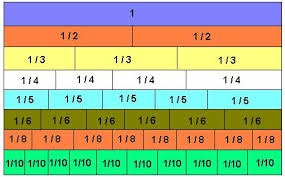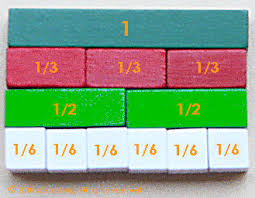Overview
The concept of dividing a whole into parts and then dividing the parts into smaller entities is basic to mathematics. That model of division can be illustrated by manipulatives such as fraction bars and Cuisenaire rods. Equality and inequality of fractions can be demonstrated by finding their common denominators and comparing them. By comparing unequal fractions and finding more fractions between them, students can show the density of the number line.
Dividing a Whole into Parts
A fraction is a part of a whole. Children can illustrate the concept by taking a whole circle, then cutting the circle in half, then cutting each half into halves to show fourths, then cutting each fourth into eighths, and so forth. Many different nations in ancient times, such as the Egyptians, Hindus, and Babylonians used fractions in different computations. The Arabs separated the numerator and a denominator by a bar between them.
Illustrating the Model
Manipulatives such as fraction bars and Cuisenaire rods are special types of objects that can be used to illustrate the equality or inequality of fractions. Ten white cubes equal the same length as one orange rod, and so do five red rods. It can be shown that one red rod is the same length as two white cubes, in symbol terms 2/10 = 1/5. Similarly, 3 white cubes, or 3/10, is not the same size as 1 purple rod, or 1/3.
Finding Common Denominators
The best method to test whether fractions are equal or unequal is to find a common denominator for all the fractions in the group and then compare them. Suppose the fractions are 5/8 and 3/5. The fraction 5/8 is equal to 25/40, but the fraction 3/5 is equal to 24/40. They are not equal. Suppose the fractions are 3/5 and 6/10. Since 3/5 is equal to 6/10, the fractions are equal.
Density of the Number Line
There is always another fraction that can be found between any two fractions on the number line. Take a closer look at the section between 0 and 1 on the number line. At first glance, it appears full. Halfway between 0 and 1 is ½, and halfway between that is ¼, and halfway between that is 1/8, then 1/16, then 1/32, and then there’s a point for ¾, and there’s also a point for 3/8, 5/8, and 7/8, 1/16, 3/16, 5/16, 7/16, 1/32, 3/32, and so on. Fractions are dense along the number line.
Interested in math tutoring services? Learn more about how we are assisting thousands of students each academic year.
SchoolTutoring Academy is the premier educational services company for K-12 and college students. We offer tutoring programs for students in K-12, AP classes, and college. To learn more about how we help parents and students in Bluewater, ON, Canada: visit Tutoring in Bluewater, ON, Canada




